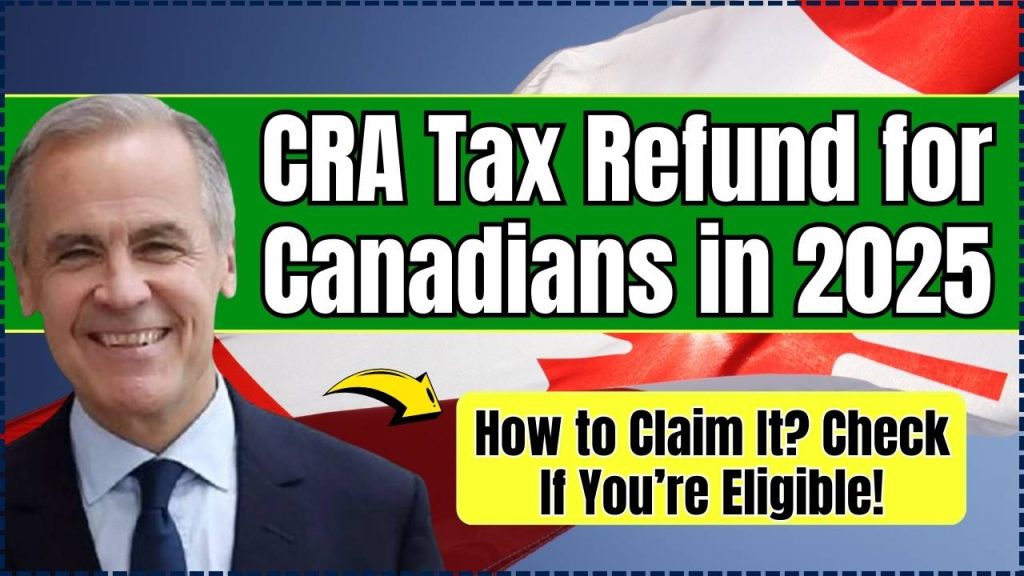CRA Tax Refund for Canadians in 2025: Canadians looking forward to a CRA tax refund in 2025 will be pleased to know that the Canada Revenue Agency (CRA) is making it easier than ever to file and get your money back. Whether you’re a student, a full-time worker, a retiree, or self-employed, knowing how to claim your refund can mean hundreds or even thousands of dollars in your pocket.

CRA Tax Refund for Canadians in 2025
| Feature | Details |
|---|---|
| CRA Tax Refund for 2025 | Issued after filing 2024 tax return |
| Eligibility | Overpaid taxes, eligible credits, or deductions |
| Deadline to File | April 30, 2025 (June 15 for self-employed, but payment due by April 30) |
| How to File | NETFILE-certified software, paper filing, or tax professional |
| Refund Timeframe | 2 weeks (online); 8 weeks (paper) |
| Direct Deposit Option | Available via CRA My Account |
| Official Website | CRA Refund Info |
Claiming your CRA tax refund for 2025 doesn’t have to be complicated. With the right documents, tools, and timing, you can make the process fast and stress-free. Whether you’re looking to get money back for tuition, childcare, medical expenses, or RRSP contributions, the CRA offers several ways to help you optimize your return.
And remember, your refund isn’t just extra money—it’s a reward for making smart financial decisions. File early, file accurately, and stay organized.
What is a CRA Tax Refund?
A CRA tax refund is money the government returns to you if you paid more income tax during the year than what you actually owed. This overpayment could be the result of payroll deductions made by your employer, or because you claimed various tax credits, deductions, and benefits that lower your total tax liability.
For instance, let’s say you earned $50,000 in 2024 and paid $7,500 in income tax. But after claiming deductions like RRSP contributions, medical expenses, and tuition credits, your total tax payable drops to $6,000. That means you get $1,500 back as a refund. This money is yours to save, invest, or spend on essentials like rent, groceries, or school fees.
These refunds aren’t just about getting cash back—they also signal that you’re making smart financial choices, such as contributing to retirement savings or claiming educational benefits.
Who Is Eligible for a Tax Refund in 2025?
Eligibility for a CRA tax refund depends on a variety of factors:
- You overpaid taxes through employer deductions or quarterly instalments.
- You claimed refundable tax credits, such as:
- GST/HST Credit
- Canada Workers Benefit (CWB)
- Climate Action Incentive Payment (CAIP)
- You contributed to tax-sheltered accounts like RRSPs.
- You qualify for non-refundable or partially refundable credits like:
- Disability Tax Credit (DTC)
- Canada Caregiver Credit
- Tuition and education credits
Even if you had little or no income in 2024, filing a tax return is crucial. It ensures you stay eligible for government benefits, such as:
- Canada Child Benefit (CCB)
- GST/HST Credit
- Guaranteed Income Supplement (GIS)
How to Claim Your CRA Tax Refund in 2025
Step 1: Gather All Required Documents
Proper documentation is the foundation of a successful tax return. Make sure you collect:
- T4 slips for employment income
- T5 slips for interest/dividends
- T3 slips for trust income
- RRSP contribution receipts (especially for early 2025)
- Tuition receipts (T2202)
- Rent receipts (in some provinces like Ontario or Manitoba)
- Childcare expenses
- Medical bills or prescriptions
- Donation receipts
Step 2: Choose Your Filing Method
Online (Fastest Option)
- Use NETFILE-certified tax software like TurboTax, Wealthsimple Tax, UFile, or H&R Block.
- Log in to CRA My Account to auto-populate many fields and avoid errors.
- You can file directly from your smartphone or desktop.
Paper Filing
- Download the 2024 General Income Tax Package.
- Print and fill in forms manually.
- Mail them to the correct CRA Tax Centre.
Hire a Professional
- If your situation includes self-employment, foreign income, rental properties, or investment portfolios, it may be worth hiring a certified tax professional.
Step 3: Submit Before the Deadline
Deadlines matter. Missing them could lead to penalties or delays in your refund:
- April 30, 2025: Deadline for most Canadians
- June 15, 2025: Deadline for self-employed individuals or those with a self-employed spouse
- April 30, 2025: Still the payment due date for all, even self-employed
Step 4: Get Your Refund
After filing:
- If filed online and with direct deposit enabled, expect your refund in as little as 8 business days.
- For paper returns, wait 6 to 8 weeks.
- Check your refund status:
- Log in to CRA My Account
- Call 1-800-959-1956 for automated updates
Common Reasons for Tax Refund Delays
If you’re waiting longer than expected, these could be the culprits:
- Typing errors in your SIN or address
- Not updating your direct deposit info after switching banks
- Filing a paper return during peak season
- Missing information or supporting documents
- Your return has been selected for manual review by the CRA
Want to speed things up? Opt for online filing, double-check your information, and set up direct deposit before you file.
How Much Could You Get?
Refunds vary depending on how much tax you paid and what deductions or credits you can claim. Let’s look at some common scenarios:
| Scenario | Estimated Refund |
| Student with tuition credits and no full-time job | $1,200 |
| Family with 2 kids and eligible childcare expenses | $3,000+ |
| Senior claiming age and pension income amounts | $800 – $1,500 |
| Self-employed writer with home office and car expenses | $2,500+ |
Tips to Maximize Your Tax Refund
Here are several ways to boost your refund:
- Top up your RRSP before the March 1, 2025 deadline
- Bundle medical expenses from 12-month periods ending in 2024
- Don’t forget about moving expenses if you relocated for school or work
- Claim childcare costs if both parents work or attend school
- Use carry-forward tuition credits if you didn’t need them last year
- Keep track of union dues, work-from-home expenses, and interest on student loans
Every credit you miss is money left on the table. Keep digital receipts using an app like Expensify or just organize your files by category.
How to Get Canada’s $250 GST Relief Payment in 2025 – Check Eligibility Criteria and Payment Dates!
Extra GST Payment Canada 2025: Upcoming Payment Date Announced
Canada’s Small Business Carbon Rebate: Check Eligibility Criteria and Payment Dates!
FAQs About CRA Tax Refund for Canadians in 2025
What if I made a mistake on my return?
You can correct it using CRA’s ReFILE service (available through most tax software), or by submitting a T1 Adjustment Request.
Can I get a refund if I didn’t work or had low income?
Yes! You may still be eligible for refundable credits such as:
- GST/HST Credit
- Canada Workers Benefit
- Climate Action Incentive
These credits can lead to a refund even if you paid no tax.
How do I set up direct deposit?
Sign in to CRA My Account, then click “Direct Deposit” under the Profile section. You’ll need your banking info (institution number, transit number, account number).
Is it worth filing early?
Absolutely. Early filers get their refunds faster and have more time to fix issues if the CRA flags anything.
I’m self-employed. Can I still get a refund?
Yes! If your business expenses reduce your taxable income enough, or if you qualify for refundable credits, you could receive a refund.











